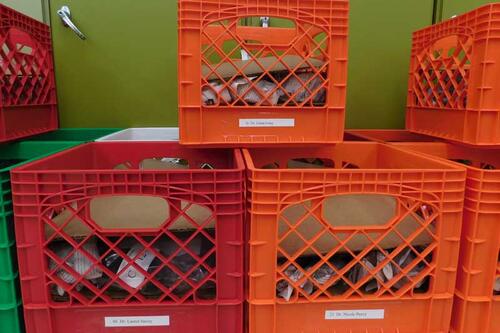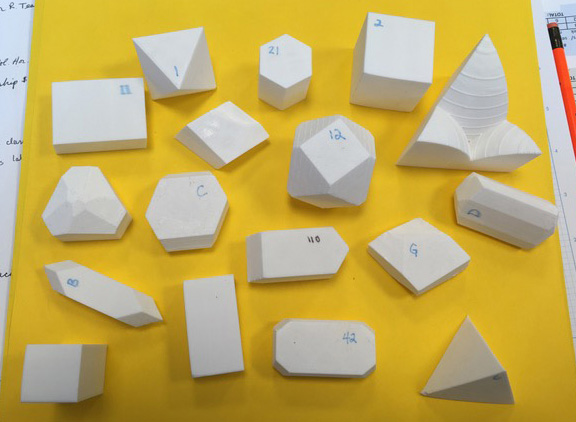
Milk crates of rock samples were delivered to each Stratigraphy student this fall. (Photo provided)
Geology is a very hands-on, location-based field of study, so remote learning presented some initial challenges for SUNY Geneseo’s geological sciences faculty. The innovations they introduced to ensure student success have proven so effective that they’ll carry into post-pandemic teaching.
Mineralogy—the first upper-level course for geology majors—traditionally relies on Krantz wooden crystal models to illustrate symmetry, shapes, and angles. Course instructor Dori Farthing, associate professor and chair of geological sciences, needed a reasonable and low-cost replacement for the models when faced with the fall semester’s laboratory limitations, sanitizing protocols, and emphasis on virtual learning.
 Her solution? “We 3D printed a vast number of crystals,” she says. Each Mineralogy student received a bag with 16 different crystals to keep for the semester. Farthing says using them as reference improved her virtual lessons, but students also benefitted from having something they could touch. “I can show a crystal to you on a screen, but the more students look at and touch and twist and rotate these samples, the easier the scientific concepts we’re working on become,” she says. “If they’re fiddling with crystals at two in the morning while they’re actually writing an English paper, I love that.”
Her solution? “We 3D printed a vast number of crystals,” she says. Each Mineralogy student received a bag with 16 different crystals to keep for the semester. Farthing says using them as reference improved her virtual lessons, but students also benefitted from having something they could touch. “I can show a crystal to you on a screen, but the more students look at and touch and twist and rotate these samples, the easier the scientific concepts we’re working on become,” she says. “If they’re fiddling with crystals at two in the morning while they’re actually writing an English paper, I love that.”
Carlo Tobia ’22, a geological sciences and adolescence education major from Wantagh, NY, appreciated the virtual class's physical supplement. “It’s difficult to completely grasp a concept like crystal form on a computer, and these models allowed for a hands-on experience,” he says.
Stratigraphy—an exploration of sedimentary rocks—is a course heavily dependent on specimen analysis and student field trips to describe and make interpretations of the strata. Prevented by the pandemic from bringing students to the rocks, professor of geological sciences Jeffrey Over chose to bring the rocks to his students. Over spent the summer gathering rocks from geological locations around New York State, as well as receiving materials from colleagues and alumni in Massachusetts, Colorado, and Texas. The specimens were then cut and labeled so each Stratigraphy student had a milk crate of samples for two labs, study, and exams. Accompanying photos of where the rock came from gave scale and context to the specimens, and Over named the crates after eminent paleontologists and stratigraphers, all women.
Farthing’s crystal bags and Over’s rock crates help them generate uniform conversations in their virtual classrooms, but students gain more than a common terminology from the tactile experience.
“We’re not creating pre-packaged classes and telling students ‘Go do it,’” Farthing says. “We’re equipping students with the tools to collaborate virtually at a time when they can’t gather around shared samples in a lab. By continuing to provide a quality course experience, we’re ensuring students stay on track to complete their degrees on schedule. And we’re helping them develop a sense of ownership of the knowledge they gain.”